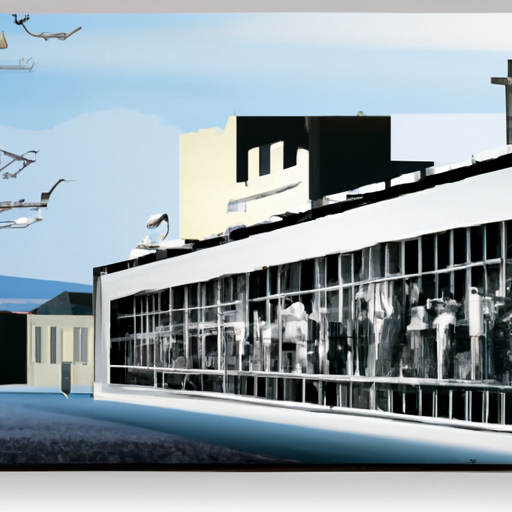Have you ever wondered how to efficiently push heat into a room? It’s a common dilemma, especially during the colder months when we all want to stay warm and cozy. Well, look no further because in this article, I’m going to share some tips and tricks to help you effectively distribute heat throughout your living space. So, if you’re tired of one room feeling like a sauna while another remains icy cold, keep reading to learn more.
When it comes to pushing heat into a room, one of the most important things to consider is airflow. Proper air circulation can make a significant difference in how warm a room feels. To achieve this, start by checking your heating system’s air filters and vents to ensure they are clean and unobstructed. Additionally, using a fan can help distribute warm air more evenly throughout the room.
Another essential factor in efficiently pushing heat into a room is insulation. Good insulation can prevent heat from escaping, making your heating efforts more effective. Check your windows and doors for drafts and consider using weather stripping or caulk to seal any gaps. Also, investing in proper insulation for your walls and attic can greatly improve heat retention.
So, whether you’re living off the grid or simply want to save on your heating bills, understanding how to efficiently push heat into a room is crucial. In the following sections, we’ll dive deeper into specific strategies and techniques you can implement to make your living space warm and cozy. Stay tuned and get ready to enjoy a comfortably heated room without breaking the bank.

Understanding Heat Transfer
Heat transfer is the movement of thermal energy from one object to another. It plays a crucial role in our daily lives, especially when it comes to keeping our homes warm and cozy during the colder months. There are three main methods of heat transfer: conduction, convection, and radiation.
Conduction
Conduction is the process of heat transfer through direct contact between two objects. When you touch a hot pan, for example, the heat is transferred from the pan to your hand through conduction. In terms of heating a room, conduction occurs when heat moves from a heat source, such as a radiator or a fireplace, to the surrounding objects in the room.
Convection
Convection involves the movement of heat through liquids or gases. It occurs when warm air rises and is replaced by cooler air, creating a cycle of heat transfer. In the context of heating a room, convection plays a significant role in distributing the heat generated by heating systems or other heat sources throughout the entire space.
Radiation
Radiation occurs when heat is transferred through electromagnetic waves. Unlike conduction and convection, radiation does not require any medium to travel. In terms of heating a room, radiation occurs when heat is emitted by a heat source, such as a fireplace or an electric heater, and is absorbed by the objects in the room, including the walls, furniture, and occupants.
Methods of Generating Heat
To efficiently push heat into a room, it is essential to choose the right heating system. Here are some popular options to consider:
Heating Systems
Central heating systems, such as furnaces or boilers, are commonly used in many homes. They distribute heat through a network of ducts or pipes, ensuring consistent warmth throughout the entire house.
Fireplace
A traditional fireplace not only adds warmth but also creates a cozy ambiance. Heat generated by the fire radiates into the room, providing a comfortable and inviting atmosphere. However, fireplaces may not be the most efficient option for heating larger spaces.
Wood Stove
Wood stoves are a popular alternative to fireplaces. They burn wood logs to generate heat, which can be distributed directly into the room. Wood stoves are known for their efficiency and can provide a significant amount of heat.
Electric Heater
Electric heaters are a convenient and cost-effective heating option. They convert electrical energy into heat and can be easily moved from room to room. However, they may not be as efficient as other heating systems for larger spaces.
Radiators
Radiators are commonly used in central heating systems. They work by heating the surrounding air, which rises and creates a convection current, distributing warmth throughout the room. Radiators can be an efficient way to heat a room, especially when combined with proper heat circulation techniques.
Choosing the Right Heating System
When selecting a heating system, several factors should be taken into consideration:
Consider Room Size
The size of the room plays a crucial role in choosing the right heating system. Smaller rooms may be adequately heated by a portable electric heater, while larger spaces may require a more powerful heating system, such as a central heating system or a wood stove.
Insulation
Proper insulation is essential for maintaining a comfortable and energy-efficient home. Insulated walls, floors, and ceilings help to retain heat and prevent drafts. Choosing a heating system that complements your insulation efforts can significantly improve heat retention and reduce energy consumption.
Energy Efficiency
Energy efficiency is a crucial factor in reducing both environmental impact and utility costs. Look for heating systems with high energy efficiency ratings, such as those certified by ENERGY STAR. These systems are designed to minimize energy waste and optimize performance.
Cost
Consider the initial cost, installation expenses, and long-term operational costs of different heating systems. Ensure that the chosen system fits within your budget while providing sufficient warmth for your needs.

Improving Heat Circulation
Once you have chosen the right heating system, it is important to focus on heat circulation techniques to ensure efficient distribution of heat within the room. Here are some strategies to improve heat circulation:
Strategic Furniture Placement
Arrange your furniture in a way that allows heat to flow freely throughout the room. Avoid placing large pieces of furniture in front of radiators or heating vents, as this can block the heat from circulating effectively.
Using Ceiling Fans
Ceiling fans can help improve heat circulation by gently pushing the warm air downwards. Set your ceiling fans to rotate clockwise during the winter months at a low speed to create a gentle breeze that circulates the warm air.
Installing Heat Radiators
Heat radiators, such as reflective panels or aluminum foil, can be installed behind radiators or heating sources. These radiators reflect heat back into the room, preventing it from being absorbed by the walls, windows, or other surfaces.
Using Heat Transfer Kits
Heat transfer kits utilize ducting and fans to transfer warm air from one room to another. This can be particularly useful in larger homes where heat distribution may be uneven.
Maximizing Heat Distribution
Maximizing heat distribution can significantly improve the overall warmth of a room. Consider these techniques to ensure efficient heat distribution:
Insulating Windows and Doors
Windows and doors are common sources of heat loss in homes. Properly insulating these areas with weather stripping, caulking, or thermal curtains can prevent drafts and keep the warm air inside.
Sealing Drafts
Identify and seal any drafts or gaps in walls, floors, and ceilings. Use weatherstripping, sealants, or insulation to prevent cold air infiltration and maintain a consistent temperature inside the room.
Using Thermal Curtains
Thermal curtains are specially designed to insulate windows and prevent heat loss. These curtains have multiple layers and a thermal lining that helps to keep the warm air inside the room.
Utilizing Heat Reflectors
Heat reflectors, such as aluminum foil or heat-resistant panels, can be placed behind radiators or attached to walls. These reflectors help to redirect the heat into the room, preventing it from being absorbed by the walls.
Heat Pushing Techniques
In addition to improving heat circulation and maximizing heat distribution, there are specific techniques you can employ to effectively push heat into a room:
Heat Transfer through Flooring
Certain types of flooring, such as tile or stone, can feel cold to the touch. To combat this, consider using area rugs or carpets to insulate the floor and prevent heat loss through the ground.
Radiant Floor Heating
Radiant floor heating involves installing a system of pipes or electric heating elements beneath the floor surface. This system heats the floor, providing radiant warmth to the entire room. Radiant floor heating can be an efficient and comfortable way to push heat into a room.
Heat Venting
By partially closing the heating vents in rooms that receive adequate warmth, you can redirect more heat to rooms that require additional heating. This technique helps to balance heat distribution throughout the house.
Reverse Ceiling Fans
During the winter months, you can reverse the direction of your ceiling fans to push warm air downwards. This simple adjustment can help distribute heat more evenly throughout the room.
Utilizing HVAC Systems
For those with central heating and cooling systems, maximizing their effectiveness can significantly improve heat distribution. Consider the following tips:
Ductwork Design
Ensure that your ductwork is properly designed and sized to allow for efficient heat distribution. Poorly designed ductwork can lead to uneven heating or cooling throughout the house.
Zoning
Implementing a zoning system allows you to control the temperature in different areas or rooms independently. This enables you to direct more heat to rooms that require additional warmth.
Balancing Airflow
Regularly check your HVAC system to ensure that the airflow is balanced. Obstructions, such as blocked vents or dirty air filters, can impede airflow, resulting in uneven heat distribution.
Regular Maintenance
Regular maintenance of your HVAC system is essential to keep it operating at peak efficiency. Schedule professional inspections and cleanings, and replace air filters as necessary. Proper maintenance helps to ensure optimal heat distribution throughout your home.
Effective Use of Insulation
Insulation is a key factor in maintaining a comfortable and energy-efficient home. Properly insulating different areas of your house can significantly impact heat distribution. Consider these insulation techniques:
Insulating Walls
Insulating the walls helps to prevent heat loss through them. Adding insulation material such as fiberglass batts or blown-in cellulose can significantly reduce heat transfer and improve heat distribution.
Attic Insulation
Attics are common areas where heat can escape. Proper attic insulation, such as fiberglass, spray foam, or cellulose insulation, can prevent heat loss through the roof, improving heat distribution in the rooms below.
Floor Insulation
Insulating crawl spaces or the area beneath your floors can help prevent cold air from infiltrating the room. This is particularly important for rooms or areas located above unheated spaces, such as garages or basements.
Pipe Insulation
Insulating hot water pipes can help retain heat and prevent heat loss during transportation. This ensures that hot water arrives at its destination without losing unnecessary heat along the way.
Energy-Efficient Tips
To make your heating system more energy-efficient and reduce your environmental impact, consider implementing these tips:
Smart Thermostats
Investing in a smart thermostat allows you to program and control the temperature based on your schedule, reducing energy waste. Some smart thermostats can even learn your preferences and adjust accordingly.
Programmable Timers
Using programmable timers for your heating system enables you to set specific time intervals for when the system turns on and off. This allows you to save energy by only heating the room when it is necessary.
Energy-Efficient Appliances
Replacing outdated or energy-intensive appliances with energy-efficient models can significantly reduce energy consumption. Look for appliances with high efficiency ratings, such as ENERGY STAR certified products.
Proper Ventilation
Good ventilation is crucial for maintaining a healthy indoor environment. Ensure that your home is properly ventilated to prevent the buildup of moisture and pollutants, which can affect both comfort and energy efficiency.
Conclusion
Efficiently pushing heat into a room is essential for maintaining comfort and reducing energy consumption. By understanding the different methods of heat transfer and choosing the right heating system for your needs, you can achieve optimal heat distribution. Implementing heat circulation techniques, maximizing heat distribution, and utilizing specific heat pushing techniques further enhance the efficiency of your heating system. Proper insulation, effective use of HVAC systems, and energy-efficient practices also contribute to comfortable and efficient heating. By applying these techniques, you can create a warm and inviting space while reducing your environmental impact and enjoying cost savings.




